ART NEWS:Nov.04
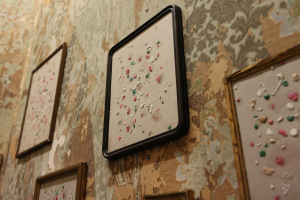 For the exhibition “La Vita Materiale: Otto Stanze, Otto Storie”, Marina Dacci has invited eight female Italian artists to showcase their works with the aim of enhancing a female artistic practice that expertly connects the artistic path to personal experience and the link between art and life in all its complexity and fertility. The viewer is invited to discover eight habitats, eight environments to which each artist has given a title; rooms in which each of them has proposed their own world, the work in the study and in which it clearly appears that matter, in its transformation processes, is something “organic” and vital. They present themselves in a confident manner, which does not distort and intimidate the visitor, but which favors his ability to venture into the game of discovery. The exhibition involves and interrogates the senses: vision and touch in particular, because our experience passes through the body that creates synesthesia with its surroundings. Info: Curator: Marina Dacci, Palazzo da Mosto, Via Giovanni Battista Mari, Reggio Emilia, Duration: 17/11/18-3/3/19, www.fondazionemanodori.it
For the exhibition “La Vita Materiale: Otto Stanze, Otto Storie”, Marina Dacci has invited eight female Italian artists to showcase their works with the aim of enhancing a female artistic practice that expertly connects the artistic path to personal experience and the link between art and life in all its complexity and fertility. The viewer is invited to discover eight habitats, eight environments to which each artist has given a title; rooms in which each of them has proposed their own world, the work in the study and in which it clearly appears that matter, in its transformation processes, is something “organic” and vital. They present themselves in a confident manner, which does not distort and intimidate the visitor, but which favors his ability to venture into the game of discovery. The exhibition involves and interrogates the senses: vision and touch in particular, because our experience passes through the body that creates synesthesia with its surroundings. Info: Curator: Marina Dacci, Palazzo da Mosto, Via Giovanni Battista Mari, Reggio Emilia, Duration: 17/11/18-3/3/19, www.fondazionemanodori.it
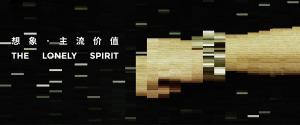 The exhibition “The Lonely Spirit” juxtapose contemporary art with other artistic creation and productive forms in China. The latter include but not limited to theater, documentaries, films, internet culture, subcultures, literature, and debates in thought, For the Chinese society and its cultural reality at the turn of the 21st Century, to be able to identify the mainstream value serves as the key to the understanding of Chinese culture, including its artistic representations, its shifting taste as well as its conceptual coordinates. However, there is still very little agreement concerning what mainstream value is, how many variations there exist, and what they can do. Therefore, we might have to adopt—odd may it seem—the plural form of the term, “mainstream values” in the Chinese in the Chinese context; in other words, mainstream value has to stay plural when it comes to contemporary China. These “mainstream values” are often embodied in the juxtaposition of trans-historical, cross-territorial existences of multifarious temporalities, and can appear as the amalgamation of creeds diametrically different and constantly cancel one another out. Info: Curators: Dai Jinhua and Su Wei, Assistant Curator: Yang Tiange, Beijing Inside-Out Art Museum, No.50, Xingshikou Road, Haidian District, Beijing, Duration: 18/11/18-24/3/19, Days & Hours: Wed-Fri 11:00-18:00, Sat-Sun 10:00-18:00, www.ioam.org.cn
The exhibition “The Lonely Spirit” juxtapose contemporary art with other artistic creation and productive forms in China. The latter include but not limited to theater, documentaries, films, internet culture, subcultures, literature, and debates in thought, For the Chinese society and its cultural reality at the turn of the 21st Century, to be able to identify the mainstream value serves as the key to the understanding of Chinese culture, including its artistic representations, its shifting taste as well as its conceptual coordinates. However, there is still very little agreement concerning what mainstream value is, how many variations there exist, and what they can do. Therefore, we might have to adopt—odd may it seem—the plural form of the term, “mainstream values” in the Chinese in the Chinese context; in other words, mainstream value has to stay plural when it comes to contemporary China. These “mainstream values” are often embodied in the juxtaposition of trans-historical, cross-territorial existences of multifarious temporalities, and can appear as the amalgamation of creeds diametrically different and constantly cancel one another out. Info: Curators: Dai Jinhua and Su Wei, Assistant Curator: Yang Tiange, Beijing Inside-Out Art Museum, No.50, Xingshikou Road, Haidian District, Beijing, Duration: 18/11/18-24/3/19, Days & Hours: Wed-Fri 11:00-18:00, Sat-Sun 10:00-18:00, www.ioam.org.cn
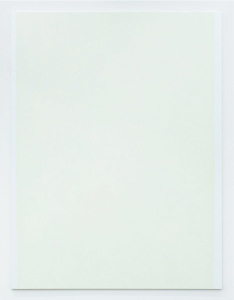 Jannis Schroeder, develops a captivating ascetic abstract painterly practice which needs space to be seen and understood. His solo exhibition at Meessen De Clercq Gallery occupies the three spaces of the ground floor. His works place a particular emphasis on method and technique. Rather than producing a series or developing a signature style, Schroeder systematically employs certain parameters. For example, the dimensions of each canvas are 170-300 cm high and 130-210 cm wide. The color takes the form of a rectangle, following the vertical format of the canvas and coinciding with its top and bottom edges. The left and right sides are demarcated by a more or less white field, which varies in shades that are defined by the enclosed central color.Through an extended process of painting and overpainting, each work ultimately develops its own rules. The finished work is a pictorial surface that is at once composed and dynamic. It reflects the process of its own making, by rendering readable the distinctive set of choices, gestures and corrections that determined it. Info: Meessen De Clercq Gallery, Abdijstraat 2a Rue de l’Abbaye, Brussels, Duration: 23/11-22/12/18, Days & Hours: Tue-Sat 11:00-18:00, www.meessendeclercq.be
Jannis Schroeder, develops a captivating ascetic abstract painterly practice which needs space to be seen and understood. His solo exhibition at Meessen De Clercq Gallery occupies the three spaces of the ground floor. His works place a particular emphasis on method and technique. Rather than producing a series or developing a signature style, Schroeder systematically employs certain parameters. For example, the dimensions of each canvas are 170-300 cm high and 130-210 cm wide. The color takes the form of a rectangle, following the vertical format of the canvas and coinciding with its top and bottom edges. The left and right sides are demarcated by a more or less white field, which varies in shades that are defined by the enclosed central color.Through an extended process of painting and overpainting, each work ultimately develops its own rules. The finished work is a pictorial surface that is at once composed and dynamic. It reflects the process of its own making, by rendering readable the distinctive set of choices, gestures and corrections that determined it. Info: Meessen De Clercq Gallery, Abdijstraat 2a Rue de l’Abbaye, Brussels, Duration: 23/11-22/12/18, Days & Hours: Tue-Sat 11:00-18:00, www.meessendeclercq.be
 Mirko Baselgia’s solo exhibition’s title “Habitat” goes back to the biological term describing a place where an organism or a community of organisms lives, including the specificities of the surrounding environment. The term originates from the Latin verb “àbitat”, meaning “it lives”, and in full it refers to all natural and artificial conditions characterizing a human settlement. Mirko Baselgia is interested in all facets of this notion, embracing the connections that vegetal species, as well as animals and humans have with each other and with the environment they live in. For the artist, the idea of “habitat” has very much to do not only with the notion of territory, but also with the soil, and the invisible life that is hidden in the underground world. Material and structural transformation processes are at the base of many works of the artist, who likes using a variety of materials, working in direct contact with them, and observing their physical and chemical transformation. Like an alchemist, through the visible alterations of the exterior world, its materials and structures, the artist also achieves an inner, personal transformation allowing him to get closer to his true self and the way he wants to live and interact with his environment. Info: Galerie Urs Meile, Rosenberghöhe 4, Lucerne, Duration: 23/11/18-3/2/19, Days & Hours: Tue-Fri 10:00-18:00, https://galerieursmeile.com
Mirko Baselgia’s solo exhibition’s title “Habitat” goes back to the biological term describing a place where an organism or a community of organisms lives, including the specificities of the surrounding environment. The term originates from the Latin verb “àbitat”, meaning “it lives”, and in full it refers to all natural and artificial conditions characterizing a human settlement. Mirko Baselgia is interested in all facets of this notion, embracing the connections that vegetal species, as well as animals and humans have with each other and with the environment they live in. For the artist, the idea of “habitat” has very much to do not only with the notion of territory, but also with the soil, and the invisible life that is hidden in the underground world. Material and structural transformation processes are at the base of many works of the artist, who likes using a variety of materials, working in direct contact with them, and observing their physical and chemical transformation. Like an alchemist, through the visible alterations of the exterior world, its materials and structures, the artist also achieves an inner, personal transformation allowing him to get closer to his true self and the way he wants to live and interact with his environment. Info: Galerie Urs Meile, Rosenberghöhe 4, Lucerne, Duration: 23/11/18-3/2/19, Days & Hours: Tue-Fri 10:00-18:00, https://galerieursmeile.com
 Eric Sidner’s exhibition “Jiggly” is about an unsteady movement. Jiggling, between states of figuration. It’s subjects organically merging and separating from the background. Permeable, fluid beings whose co-existence is determined by an entanglement with the natural world, making for an imaginary that is no less spiritual than nostalgic, an anxious reality where affect is indiscernible from sincerity. The protagonists of “Jiggly” are men born during a temporary lull of turbulence, a less threatening time when the world’s edges were softened, silent and white. They were indiscernible from the environment, surrounded by whiteness. Individuals unified under a cloak reflecting the vision of their maker. These snowmen have a tragic dimension and often depict a cartoonish antiquated masculinity, dressed in top hat, suit and pipe. Invariably smiling, almost defiant in the face of his slow decay. Info: Deborah Schamoni Gallery, Mauerkircherstr. 186, Munich, 23/11/18-9/2/19, Days & Hours: Thu-Fri 14:00-19:00, Sat 12:00-17:00, http://deborahschamoni.com
Eric Sidner’s exhibition “Jiggly” is about an unsteady movement. Jiggling, between states of figuration. It’s subjects organically merging and separating from the background. Permeable, fluid beings whose co-existence is determined by an entanglement with the natural world, making for an imaginary that is no less spiritual than nostalgic, an anxious reality where affect is indiscernible from sincerity. The protagonists of “Jiggly” are men born during a temporary lull of turbulence, a less threatening time when the world’s edges were softened, silent and white. They were indiscernible from the environment, surrounded by whiteness. Individuals unified under a cloak reflecting the vision of their maker. These snowmen have a tragic dimension and often depict a cartoonish antiquated masculinity, dressed in top hat, suit and pipe. Invariably smiling, almost defiant in the face of his slow decay. Info: Deborah Schamoni Gallery, Mauerkircherstr. 186, Munich, 23/11/18-9/2/19, Days & Hours: Thu-Fri 14:00-19:00, Sat 12:00-17:00, http://deborahschamoni.com
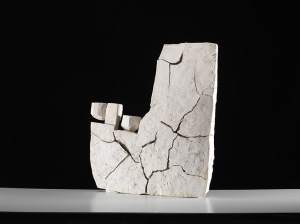 Fernando Casasempere is a sculptor working with ceramics. His work explores ideas of landscape, architecture and history but also proposes a profound sense of impending environmental collapse. Conceptually Casasempere’s use of earth and clay and his concern with nature and ecological issues connects him to artists associated with the Land or Earth Art movement, but Casasempere works out of a different cultural tradition, being profoundly inspired by the Pre-Columbian art and architecture of Latin America. For his silo exhibition “Natura Morte”, Casasempere worked with a batch of clay that reacted in unexpected ways and thereby required him to yet again explore new strategies, for example using carving for the first time. The resulting series of wall sculptures, “Natura Morta” (2018) incorporate still life elements such as bowls and pots, but also evoke ancient gravestones and burial sites. The forms of pottery, architecture and sculpture are here combined in a unique dialogue between material and technique that questions an understanding that has long cast out pottery from contemporary art. Displayed on a conveyor belt the contrast between the handmade and organic objects and the mass-produced and industrial is enhanced. Info: Parafin, 18 Woodstock Street, London, Duration: 23/11/18-2/3/19, Days & Hours: Tue–Fri 10:00-18:00, Sat 12:00-17:00, http://parafin.co.uk
Fernando Casasempere is a sculptor working with ceramics. His work explores ideas of landscape, architecture and history but also proposes a profound sense of impending environmental collapse. Conceptually Casasempere’s use of earth and clay and his concern with nature and ecological issues connects him to artists associated with the Land or Earth Art movement, but Casasempere works out of a different cultural tradition, being profoundly inspired by the Pre-Columbian art and architecture of Latin America. For his silo exhibition “Natura Morte”, Casasempere worked with a batch of clay that reacted in unexpected ways and thereby required him to yet again explore new strategies, for example using carving for the first time. The resulting series of wall sculptures, “Natura Morta” (2018) incorporate still life elements such as bowls and pots, but also evoke ancient gravestones and burial sites. The forms of pottery, architecture and sculpture are here combined in a unique dialogue between material and technique that questions an understanding that has long cast out pottery from contemporary art. Displayed on a conveyor belt the contrast between the handmade and organic objects and the mass-produced and industrial is enhanced. Info: Parafin, 18 Woodstock Street, London, Duration: 23/11/18-2/3/19, Days & Hours: Tue–Fri 10:00-18:00, Sat 12:00-17:00, http://parafin.co.uk
 The full-scale restoration of Jean Tinguely’s sound sculpture “Méta-Harmonie II” (1979) right down to the last detail at Schaulager is finished. Jean Tinguely‘s colossal sound sculptures, the Méta‑Harmonies, are considered key works in this Swiss artist’s oeuvre. “Méta‑Harmonie II” of 1979 belongs to the collection of the Emanuel Hoffmann Foundation and is one of the four sound sculptures Tinguely constructed out of scrap metal and a selection of other curious found objects. Having run for 38 years, first at Kunstmuseum Basel and later on permanent loan to the Museum Tinguely, the “sound mixing machine”, as the artist himself called it, had to be shut down, as too many mechanical parts were sorely worn and some of the built-in instruments – piano, melodica, keyboard – had broken down altogether. The team of conservators at Schaulager, under the guidance of Marcus Broecker and Carole Maître, painstakingly refurbished the kinetic sculpture in collaboration with Jean-Marc Gaillard, former assistant to the artist and conservator at Museum Tinguely. The team trawled through archives and analysed historical photographs of the work, spoke to Jean Tinguely’s friends and consulted among others musicologists as well as experts in materials technology. Their goal: to restore the sculpture’s diversity of sounds and recreate its original vibrancy. Info: Museum Tinguely, Paul Sacher-Anlage 2, 4002 Basel, Duration 24/11/18- , Days & Hours: Tue-Sun 11:00-18:00, www.schaulager.org & www.tinguely.ch
The full-scale restoration of Jean Tinguely’s sound sculpture “Méta-Harmonie II” (1979) right down to the last detail at Schaulager is finished. Jean Tinguely‘s colossal sound sculptures, the Méta‑Harmonies, are considered key works in this Swiss artist’s oeuvre. “Méta‑Harmonie II” of 1979 belongs to the collection of the Emanuel Hoffmann Foundation and is one of the four sound sculptures Tinguely constructed out of scrap metal and a selection of other curious found objects. Having run for 38 years, first at Kunstmuseum Basel and later on permanent loan to the Museum Tinguely, the “sound mixing machine”, as the artist himself called it, had to be shut down, as too many mechanical parts were sorely worn and some of the built-in instruments – piano, melodica, keyboard – had broken down altogether. The team of conservators at Schaulager, under the guidance of Marcus Broecker and Carole Maître, painstakingly refurbished the kinetic sculpture in collaboration with Jean-Marc Gaillard, former assistant to the artist and conservator at Museum Tinguely. The team trawled through archives and analysed historical photographs of the work, spoke to Jean Tinguely’s friends and consulted among others musicologists as well as experts in materials technology. Their goal: to restore the sculpture’s diversity of sounds and recreate its original vibrancy. Info: Museum Tinguely, Paul Sacher-Anlage 2, 4002 Basel, Duration 24/11/18- , Days & Hours: Tue-Sun 11:00-18:00, www.schaulager.org & www.tinguely.ch
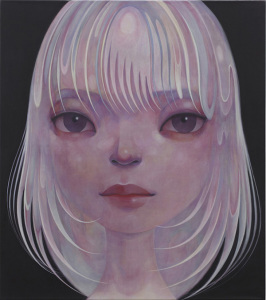 Throughout the past 17 years of his artistic practice, Hideaki Kawashima’s works have continued to undergo a series of subtle transformations. In his latest works that are on presentation at the exhibition “Youth” Kawashima takes on a new endeavor to depict multiple subjects against landscapes and specifically rendered backgrounds. Up until 2009, Kawashima had created works in which the subject’s face alone is depicted as if lightly levitating in the air against a plain background. Androgynous, ageless, and obscure as to whether human being or human soul, the long trailing hair of these heads had evoked a distinct floating sensation within space of his paintings. From around 2010, he began to turn his perspective towards painting portraits that were clearly distinguishable as “human beings,” depicting not only the head but also the upper section of the body, with each subject in different hairstyles and clothing. While their eyes remain remarkably impressionable, they came to harbor a sense of melancholy more so than strength. Although such change had been attributed to Kawashima “turning his eyes to other people in an intent to return his overly bloated self-conscious away from such inward-gazing introspection to neutrality,” the artist himself looks back on this and states follows. Info: Tomio Koyama Gallery, Complex 665 2F, 6-5-24 Roppongi, Minato-ku, Tokyo, Duration 24/11-22/12/18, Days & Hours: Daily 11:00-20:00, http://tomiokoyamagallery.com
Throughout the past 17 years of his artistic practice, Hideaki Kawashima’s works have continued to undergo a series of subtle transformations. In his latest works that are on presentation at the exhibition “Youth” Kawashima takes on a new endeavor to depict multiple subjects against landscapes and specifically rendered backgrounds. Up until 2009, Kawashima had created works in which the subject’s face alone is depicted as if lightly levitating in the air against a plain background. Androgynous, ageless, and obscure as to whether human being or human soul, the long trailing hair of these heads had evoked a distinct floating sensation within space of his paintings. From around 2010, he began to turn his perspective towards painting portraits that were clearly distinguishable as “human beings,” depicting not only the head but also the upper section of the body, with each subject in different hairstyles and clothing. While their eyes remain remarkably impressionable, they came to harbor a sense of melancholy more so than strength. Although such change had been attributed to Kawashima “turning his eyes to other people in an intent to return his overly bloated self-conscious away from such inward-gazing introspection to neutrality,” the artist himself looks back on this and states follows. Info: Tomio Koyama Gallery, Complex 665 2F, 6-5-24 Roppongi, Minato-ku, Tokyo, Duration 24/11-22/12/18, Days & Hours: Daily 11:00-20:00, http://tomiokoyamagallery.com
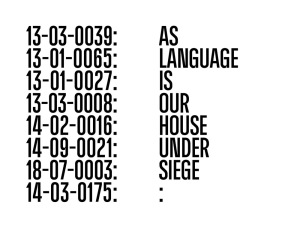 Tanya Leighton announces the Inaugurative Participation Overture of 6,985 Lexical Items from the Focal Vocabulary Index of Studio for Propositional Cinema. The Focal Vocabulary Index is an inventory of all Lexical Items (words, compound words, punctuation, etc.) that have been used as material in the construction of works publicly disseminated by Studio for Propositional Cinema since their inauguration in Düsseldorf in 2013. The exhibition, presents 15 exemplary exhibits of Lexical Items and Lexical Structures selected and constructed in various manners, including four new Lexical Structures constructed by Studio for Propositional Cinema. It includes another Lexical Structure constructed by Irena Haiduk, as well as various Lexical Items selected variously by the brokering party, data analysis (e.g. frequency of use), for expressive function, and through aleatoric processes. Each Lexical Item is categorised as Concrete, Conditional, or Connective. All Concrete and Conditional Items are subject to a co-licensing agreement between Studio for Propositional Cinema and a second party licensee, permitting the license holder to use and display the Item in exchange for a mutually determined one-time unit of exchange. Info: Tanya Leighton, Kurfürstenstraße 156 & 24/25, Berlin, Duration: 27/11/18-19/1/19, Days & Hours: Tue-Sun 11:00-18:00, www.tanyaleighton.com
Tanya Leighton announces the Inaugurative Participation Overture of 6,985 Lexical Items from the Focal Vocabulary Index of Studio for Propositional Cinema. The Focal Vocabulary Index is an inventory of all Lexical Items (words, compound words, punctuation, etc.) that have been used as material in the construction of works publicly disseminated by Studio for Propositional Cinema since their inauguration in Düsseldorf in 2013. The exhibition, presents 15 exemplary exhibits of Lexical Items and Lexical Structures selected and constructed in various manners, including four new Lexical Structures constructed by Studio for Propositional Cinema. It includes another Lexical Structure constructed by Irena Haiduk, as well as various Lexical Items selected variously by the brokering party, data analysis (e.g. frequency of use), for expressive function, and through aleatoric processes. Each Lexical Item is categorised as Concrete, Conditional, or Connective. All Concrete and Conditional Items are subject to a co-licensing agreement between Studio for Propositional Cinema and a second party licensee, permitting the license holder to use and display the Item in exchange for a mutually determined one-time unit of exchange. Info: Tanya Leighton, Kurfürstenstraße 156 & 24/25, Berlin, Duration: 27/11/18-19/1/19, Days & Hours: Tue-Sun 11:00-18:00, www.tanyaleighton.com
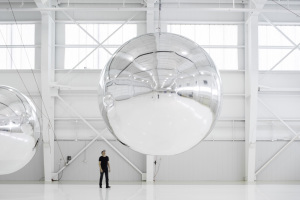 The Nam June Paik Art Center Prize was established in 2009. Since its inception, the Prize has been awarded to artists and theorists whose works are very much in tune with Paik’s work amalgamating art and technology, pursuing new ways of communication, interacting with audiences, and fusing and conflating music, performance and visual art. The Selection Committee of Nam June Paik Art Center Prize has selected Trevor Paglen as the winner of the 2018 Prize. KimHong-hee, head of The Selection Committee said, “Paglen allusively exposes the secret surveillance equipment of the military and intelligence organizations by means of different mediums such as photography, video, sculpture and installation. Starting from “Drone Vision” to his recent work “A Study of Invisible Images” with its enigmatic paradox of ‘invisible image,’ his series of demapping and remapping unveils the digital world’s contradiction and internal violence in a political and metaphorical way Paglen will be awarded KRW 50,000,000, and have the opportunity to hold a solo exhibition at Nam June Paik Art Center in 2019. Paglen has been invited to Korea for the Prize Ceremony and special talk. Info: Nam June Paik Art Center, 10 Paiknamjune-ro, Giheung-gu, Yongin-si, Gyeonggi-do, Day 30/11/18, 15:00, https://njpac-en.ggcf.kr
The Nam June Paik Art Center Prize was established in 2009. Since its inception, the Prize has been awarded to artists and theorists whose works are very much in tune with Paik’s work amalgamating art and technology, pursuing new ways of communication, interacting with audiences, and fusing and conflating music, performance and visual art. The Selection Committee of Nam June Paik Art Center Prize has selected Trevor Paglen as the winner of the 2018 Prize. KimHong-hee, head of The Selection Committee said, “Paglen allusively exposes the secret surveillance equipment of the military and intelligence organizations by means of different mediums such as photography, video, sculpture and installation. Starting from “Drone Vision” to his recent work “A Study of Invisible Images” with its enigmatic paradox of ‘invisible image,’ his series of demapping and remapping unveils the digital world’s contradiction and internal violence in a political and metaphorical way Paglen will be awarded KRW 50,000,000, and have the opportunity to hold a solo exhibition at Nam June Paik Art Center in 2019. Paglen has been invited to Korea for the Prize Ceremony and special talk. Info: Nam June Paik Art Center, 10 Paiknamjune-ro, Giheung-gu, Yongin-si, Gyeonggi-do, Day 30/11/18, 15:00, https://njpac-en.ggcf.kr
